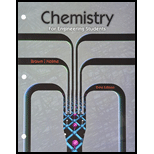
Concept explainers
Interpretation:
You work in a semiconductor production plant that relies on several chlorofluorocarbons in its manufacturing process. One day, you find an unlabeled gas cylinder, and you are assigned to figure out what is in the tank. First, you fill a 1.000-L flask with the gas. At a pressure of 250.0 torr and a temperature of 25.000C, you determine that the mass of the gas in the flask is 2.2980 g. Then, you send the flask to an outside lab for elemental analysis, and they report that the gas contains 14.05% C, 44.46% F, and 41.48% Cl by mass. The molecular formula of this gas should be identified.
Concept introduction:
An ideal gas which is known as the perfect gas is a gas whose volume V, Pressure P and temperature T are related through the
Here,
-
n = Number of moles of the gas
R = Universal gas constant
T = Temperature
P = Pressure
Ideal gases are described as the molecules which have negligible size but have an average molar kinetic energy which is dependent on the temperature. When temperature is low most of the gases behave like ideal gases and the ideal
Answer to Problem 5.88PAE
Solution:
Given:
Volume of gas taken= 1.000L
Pressure = 250 torr = 0.329 atm
Temperature = (25+273) K = 298K
Mass of the gas = 2.298g
Percentage of elements present in gas:
Explanation of Solution
The ideal gas equation is as follows:
Or,
Or,
Now, the percent composition of the given elements are:
Divide all with their molar masses to get the number of atoms of each element as follows
Now, divide with the smallest number to calculate the empirical formula:
So, the empirical formula is
Calculate empirical formula mass as follows:
Now,
Or,
Where,
Thus,
Therefore, the molecular formula is
Ideal gases are described as the molecules which have negligible size but have an average molar kinetic energy which is dependent on the temperature. Using the ideal gas equation, the calculated molecular formula of gas is
Want to see more full solutions like this?
Chapter 5 Solutions
Bundle: Chemistry for Engineering Students, 3rd, Loose-Leaf + OWLv2 with Quick Prep and Student Solutions Manual 24-Months Printed Access Card
- Synthesize 1,4-dibromobenzene from acetanilide (N-phenylacetamide) using the necessary organic or inorganic reagents. Draw the structures of the compounds.arrow_forwardIndicate the products obtained by mixing (3-oxo-3-phenylpropyl)triphenylphosphonium bromide with sodium hydride.arrow_forwardWe mix N-ethyl-2-hexanamine with excess methyl iodide and followed by heating with aqueous Ag2O. Indicate the major products obtained.arrow_forward
- Indicate the products obtained by mixing acetophenone with iodine and NaOH.arrow_forwardIndicate the products obtained by mixing 2-Propanone and ethyllithium and performing a subsequent acid hydrolysis.arrow_forwardIndicate the products obtained if (E)-2-butenal and 3-oxo-butanenitrile are mixed with sodium ethoxide in ethanol.arrow_forward
- Question 3 (4 points), Draw a full arrow-pushing mechanism for the following reaction Please draw all structures clearly. Note that this intramolecular cyclization is analogous to the mechanism for halohydrin formation. COH Br + HBr Brarrow_forwardIndicate the products obtained if 2,2-dimethylpropanal and acetaldehyde are mixed with sodium ethoxide in ethanol.arrow_forwardIndicate the products obtained if 2,2-dimethylpropanal and acetaldehyde are reacted with sodium ethoxide in ethanol.arrow_forward
- 2,2-Dimethylpropanal and acetaldehyde are reacted with sodium ethoxide in ethanol. Indicate the products obtained.arrow_forwardAdd conditions above and below the arrow that turn the reactant below into the product below in a single transformationADS fint anditions 百 Abl res condinese NC ง Add on condtions 1.0 B H,N.arrow_forward3. Provide all the steps and reagents for this synthesis. OHarrow_forward
 Chemistry for Engineering StudentsChemistryISBN:9781337398909Author:Lawrence S. Brown, Tom HolmePublisher:Cengage Learning
Chemistry for Engineering StudentsChemistryISBN:9781337398909Author:Lawrence S. Brown, Tom HolmePublisher:Cengage Learning Chemistry: The Molecular ScienceChemistryISBN:9781285199047Author:John W. Moore, Conrad L. StanitskiPublisher:Cengage Learning
Chemistry: The Molecular ScienceChemistryISBN:9781285199047Author:John W. Moore, Conrad L. StanitskiPublisher:Cengage Learning ChemistryChemistryISBN:9781305957404Author:Steven S. Zumdahl, Susan A. Zumdahl, Donald J. DeCostePublisher:Cengage Learning
ChemistryChemistryISBN:9781305957404Author:Steven S. Zumdahl, Susan A. Zumdahl, Donald J. DeCostePublisher:Cengage Learning Chemistry: An Atoms First ApproachChemistryISBN:9781305079243Author:Steven S. Zumdahl, Susan A. ZumdahlPublisher:Cengage Learning
Chemistry: An Atoms First ApproachChemistryISBN:9781305079243Author:Steven S. Zumdahl, Susan A. ZumdahlPublisher:Cengage Learning
 Chemistry: Principles and ReactionsChemistryISBN:9781305079373Author:William L. Masterton, Cecile N. HurleyPublisher:Cengage Learning
Chemistry: Principles and ReactionsChemistryISBN:9781305079373Author:William L. Masterton, Cecile N. HurleyPublisher:Cengage Learning





